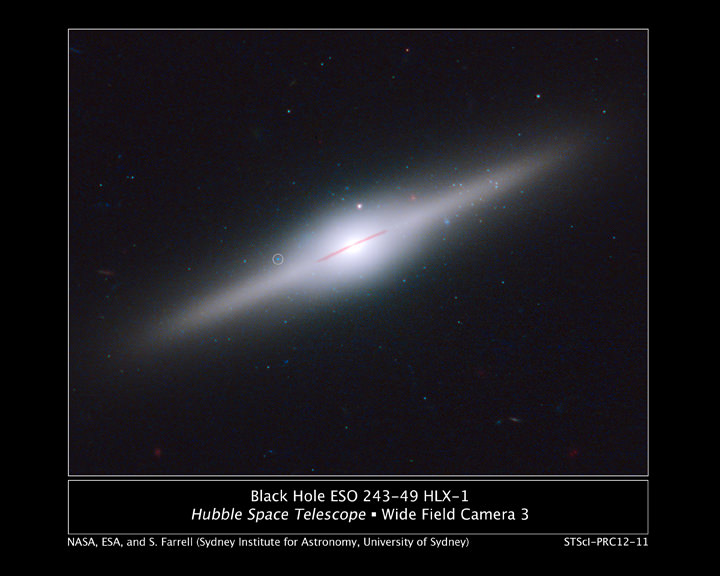[/caption]
Score another first for NASA’s Hubble Space Telescope! Along with observations taken with the Swift X-ray telescope, a team of astronomers have identified a young stellar cluster of stars pointing the way towards the first verified intermediate mass black hole. This grouping of stars provides significant indication that black holes of this type may have been at the center of a now shredded dwarf galaxy – a finding which increases our knowledge of galaxy evolution.
“For the first time, we have evidence on the environment, and thus the origin, of this middle-weight black hole,” said Mathieu Servillat, a member of the Harvard-Smithsonian Center for Astrophysics research team.
Designated as ESO 243-49 HLX-1, this incredible intermediate mass black hole was discovered in 2009 by Sean Farrell, of the Sydney Institute for Astronomy in Australia, using the European Space Agency’s XMM-Newton X-ray space telescope. Hyper-Luminous X-ray Source 1 is a 20,000 solar mass beauty which resides at the edge of galaxy ESO 243-49 some 290 million light years away. However, the Newton’s findings weren’t the only contribution – HLX-1 was also verified with NASA’s Swift observatory in X-ray and Hubble in near-infrared, optical, and ultraviolet wavelengths. What stands out is the presence of a cluster of young stars encircling the black hole and stretching out across about 250 light years of space. While the stars themselves are too far away to be resolved, their magnitude and spectra match with other young clusters seen in similar galaxies.
Just what clued the team to the presence of a star cluster? In this case their instruments revealed the blue spectrum of hot gases being emitted from the accretion disk located at the periphery of the black hole… and there was more. They also noted the presence of red light spawned by cooler gases which may indicate the presences of stars. Time to match up the findings against computer modeling.
“What we can definitely say with our Hubble data is that we require both emission from an accretion disk and emission from a stellar population to explain the colors we see.” said Farrell.
Why is the presence of a young star cluster unusual? According to what we know so far, they just don’t occur outside a flattened disk such as HLX-1. This finding may indicate the intermediate mass black hole may have once been at the heart of a dwarf galaxy engaged in a merger event. The dwarf galaxy’s stars were stripped away, but not its capabilities to form new. During the interaction, the gas around the black hole was compressed and star formation began again… but how long ago?
“The age of the population cannot be uniquely constrained, with both very young and very old stellar populations allowed. However, the very old solution requires excessively high levels of disc reprocessing and an extremely small disc, leading us to favour the young solution with an age of ~13 Myr.” says the team. “In addition, the presence of dust lanes and the lack of any nuclear activity from X-ray observations of the host galaxy lead us to propose that a gas-rich minor merger may have taken place less than ~200 Myr ago. Such a merger event would explain the presence of the intermediate mass black hole and support a young stellar population.”
Discoveries such as HLX-1 will help astronomers further understand how supermassive black holes are formed. Current conjecture is that intermediate mass black holes may migrate together to form their larger counterparts. Studying the trajectory of this new find may provide valuable information… even if it is unknown at this point. HLX-1 may be drawn into a merger event and it may just end up orbiting ESO 243-49. Regardless of what happens, chances are it will fade away in X-ray as it exhausts its gas supply.
“This black hole is unique in that it’s the only intermediate-mass black hole we’ve found so far. Its rarity suggests that these black holes are only visible for a short time,” said Servillat.
Original Story Source: Harvard Center for Astrophysics News Release. For Further Reading: A Young Massive Stellar Population Around the Intermediate Mass Black Hole ESO 243-49 HLX-1.

